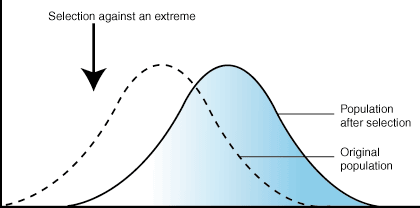Charles Darwin found fossils that looked like ancient versions of...
Modern humans are members of which species?
___ is a type of reproductive isolation in which oceans, mountains, or...
Scientist often take dirt samples from the area around the fossil...
Two organisms that are closeley related would have ___.
What is the term for a feature that allows an organism to survive...
Which of the following is a term for a group of similar organisms that...
The process of biological change over time by which descendants come...
Why is it most common to find only the skull of an ancient hominid?
If an organism has a vestigial structure, that structure likely once...
Which of the following is a fossil?
Which effect of natural selection is depicted in the graph?
The process by which individuals that are better suited to their...
The differences between members of the same species are known as ___.
What two groups are most hominid species classified into?
Which effect of natural selection is depicted in the graph?
The ancient bipedal hominid called "Handy Man" is a member...
All of the following branches of science provide evidence for...
Modern whales have vestigieal pelvic bones and lungs instead of gills....
Which effect of natural selection is depicted in the graph?
Which term means the crossing of two different species that share...
The oldest living primate group are the ___.
Which of the following is not a characteristic of hominids?
Which theory states that floods and earthquakes have occurred often in...
A ___ is a group of individuals of the same species in the same...
Genetic variation can arise from a random change in the DNA of a gene....
A measure of how commonly a particular allele occurs in a population...
Charles Darwin's poetic grandfather was ___.
The difference in the physical traits of an individual from those of...
The combined alleles of all the individuals in a population is called...
The development by scientists of a new color in a rose is the result...
In searching for the origins of humanity, what characteristic did...
Which of the following is not a mechanism for evolution?
Which of the following facts supporting evolution would be found in...
In natural selection, the selective agent is ___.
___ is a form of reproductive isolation in which two populations...
To help unravel the mysteries of human evolution, paleoanthropologists...
The wing of an ostrich would be classified as a(n) ___.
Which scientist proposed that if an organism used a structure so much...
Which of the five mechanisms of evolution is illustrated in the...
Which of the following is not a condition for Hardy-Weinberg...
Which of the following is NOT a type of fossil?
The ancient bipedal hominid called "Taung Child" is a member...
The ancient bipedal hominid called "Lucy" is a member of...
What is the only hominid to co-exist with Homo sapiens in Europe?
Scientists attemp to date fossils by examining the radioactive...
Which of the following is not a monkey?
When an individual ___ from its population, the genetic diversity of...
When a few individuals start a new colony, it most likely results in...
When a male bird of paradise displays its tail feathers, it is...
The process by which new species arise from prior species is known as...
Humans are thought to be descendants of ___.
Which of the following facts supporting evolution would be found in...
Which scientist developed a classification system for organisms?
___ is a type of evolution in which organisms change in response to...
Bipedalism is an important adaptive advantage for all of the following...
Biogeography is the study of the ___.
___ is a type of reproductive isolation in which differing mating...
Which of the following is the youngest of this group?
___ is a process by which unrelated organisms independantly evolve...
The four principles of natural selection are variation, adaptation,...
Homo erectus is considered to be the most successful hominid species...
Approximately how long has Homo sapiens been on Earth?
A population that is not undergoing natural selection displays what...
Which of the following is the oldest of this group?
What type of selection occurs when individuals in a population with...
The movement of alleles from one population to another is called ___.
















